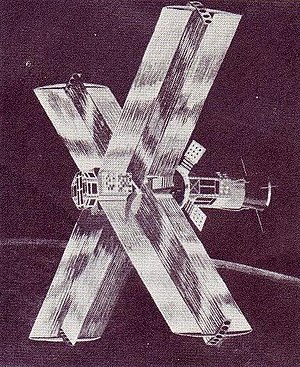 Explorer 46 satellite Explorer 46 satellite | |
| Names | Meteoroid Technology Satellite-A MTS-A |
|---|---|
| Mission type | Meteroids research |
| Operator | NASA |
| COSPAR ID | 1972-061A |
| SATCAT no. | 06142 |
| Spacecraft properties | |
| Spacecraft | Explorer XLVI |
| Spacecraft type | Meteoroid Technology Satellite |
| Bus | MTS |
| Manufacturer | Langley Research Center |
| Launch mass | 90 kg (200 lb) |
| Start of mission | |
| Launch date | 13 August 1972, 15:10 UTC |
| Rocket | Scout D-1 (S-184C) |
| Launch site | Wallops Flight Facility, LA-3A |
| Contractor | Vought |
| Entered service | 13 August 1972 |
| End of mission | |
| Decay date | 2 November 1979 |
| Orbital parameters | |
| Reference system | Geocentric orbit |
| Regime | Low Earth orbit |
| Perigee altitude | 496 km (308 mi) |
| Apogee altitude | 814 km (506 mi) |
| Inclination | 37.70° |
| Period | 97.80 minutes |
| Instruments | |
| Meteoroid Penetration Meteoroid Penetration Sensors Meteoroid Velocity Sensors | |
| Explorer program← Explorer 45Explorer 47 → | |
Explorer 46, (also Meteoroid Technology Satellite-A or MTS-A), was a NASA satellite launched as part of Explorer program.
Mission
Explorer 46 was designed to provide data on the frequency and penetration energy of meteoroids and micrometeoroids in low Earth orbit. Explorer 46 consisted of a hexi-cylindrical bus covered with solar cells. Meteoroid impacts were detected and measured using bumper panels that extended after launch and gave the satellite a windmill-like appearance. The central hub of the satellite carried the velocity and impact experiments. When the bumper targets were extended from the satellite, it had an overall width of 701.50 cm (276.18 in). Twenty meteoroid impacts were recorded by the bumper panels through December 1972. A set of capacitor detectors recorded over two thousand micrometeoroid hits over the same period.
Instruments
- Multi-sheet bumper, 701.50 cm (276.18 in) across, its detectors filled with gas, to register and telemeter loss of pressure;
- 12 box-shaped velocity detectors at various locations along the spacecraft;
- Impact flux detectors, with 64 detectors to assess the population of very small particles.
Launch
Explorer 46 was launched on 13 August 1972, at 15:10 UTC, from Wallops Flight Facility (WFF), with a Scout D-1 Launch vehicle.
Experiments
Meteoroid Penetration
The objective of this experiment was to measure the meteoroid penetration rates of a bumper-protected target. Penetrations were measured, using 12 2-mil stainless-steel pressure cells located behind 1-mil stainless-steel bumpers. These 12 cells were mounted on 4 bumper panels which extended out from the cylindrical spacecraft body. Due to a malfunction, only two of the four bumper panels deployed.
Meteoroid Penetration Sensors
This experiment measured meteoroid impacts using a thin film capacitor. Due to a spacecraft malfunction, this experiment had to be turned off two weeks after launch, but it had already recorded 2000 micrometeoroid impacts by that time. It was reactivated in August 1974.
Meteoroid Velocity Sensors
This experiment measured the velocity of impacting micrometeoroids, using two thin-film capacitors and measuring the time-of-flight between them. Due to difficulties with the spacecraft, this experiment had to be turned off two weeks after launch, but it was turned on again for 1 week in August 1974.
Atmospheric entry
Explorer 46 reentered in the atmosphere on 2 November 1979.
See also
References
- ^ McDowell, Jonathan (21 July 2021). "Launch Log". Jonathan's Space Report. Retrieved 15 November 2021.
- "Trajectory: Explorer 46 (MTS) 1972-061A". NASA. 28 October 2021. Retrieved 15 November 2021.
 This article incorporates text from this source, which is in the public domain.
This article incorporates text from this source, which is in the public domain.
- "Letter dated 27 October 1972 from the Permanent Representative of the United States of America to the United Nations addressed to the Secretary-General". (72-22115). UNOOSA. 8 November 1972. Archived from the original on 2 April 2015. Retrieved 22 June 2018.
- "Satellite Explorer 46: Meteoroid Technology Satellite (backup)". Smithsonian - National Air and Space Museum. 2007. Retrieved 15 November 2021.
 This article incorporates text from this source, which is in the public domain.
This article incorporates text from this source, which is in the public domain.
- "Experiment: Meteoroid Penetration". NASA. 28 October 2021. Retrieved 15 November 2021.
 This article incorporates text from this source, which is in the public domain.
This article incorporates text from this source, which is in the public domain.
- "Experiment: Meteoroid Penetration Sensors". NASA. 28 October 2021. Retrieved 15 November 2021.
 This article incorporates text from this source, which is in the public domain.
This article incorporates text from this source, which is in the public domain.
- "Experiment: Meteoroid Velocity Sensors". NASA. 28 October 2021. Retrieved 15 November 2021.
 This article incorporates text from this source, which is in the public domain.
This article incorporates text from this source, which is in the public domain.
External links
| ← 1971Orbital launches in 19721973 → | |
|---|---|
| |
| Payloads are separated by bullets ( · ), launches by pipes ( | ). Crewed flights are indicated in underline. Uncatalogued launch failures are listed in italics. Payloads deployed from other spacecraft are denoted in (brackets). |
